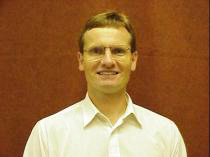
News Release
|
Office of News and Information Johns Hopkins University 901 South Bond Street, Suite 540 Baltimore, Maryland 21231 Phone: 443-287-9960 | Fax: 443-287-9920 |
July 26, 2007 FOR IMMEDIATE RELEASE CONTACT: Lisa De Nike (443) 287-9960 lde@jhu.edu |
Improves Prospects for Quantum Super Computers
An international team of scientists, including several at The Johns Hopkins University, has detected a hidden magnetic "quantum order" that extends over chains of nearly 100 atoms in a material that is otherwise magnetically disordered.
The findings, which are published online today (July 26) in
the
journal Science, may have implications for the
design of devices and
materials for quantum information processing, including
large-scale
quantum computers capable of tackling problems
exponentially faster
than can conventional computers.
 Collin Broholm |
The team's results are important because they demonstrate that the magnetic moments (the measure of the strength of a magnetic source) of a large number of atoms can band together to form quantum states much like those of a very large molecule. Though, on the surface, these atomic "compass needles" seem to be disorganized and disordered, the team was able to discern "a beautiful, underlying quantum order," said team member Collin Broholm, professor in the Henry A. Rowland Department of Physics and Astronomy at Johns Hopkins' Krieger School of Arts and Sciences.
"Quantum mechanics is normally appreciated only on the atomic scale. However, here we present evidence for a very long and very quantum mechanical magnetic molecule," Broholm said. "While disordered to a classical observer, the magnetic moments of almost 100 nickel atoms arranged in a row within a solid were shown to display an underlying quantum coherence limited only by chemical and thermal impurities. The progress we made is really a demonstration of quantum coherence among a larger number of atoms in a magnet than ever before."
In addition, the team has established the factors that affect the distance over which the hidden "quantum order" can be maintained.
That distance, as well as how it changes as a result of heating and chemical impurities in the material, may well prove to be essential in determining whether the material will have practical applications.
The team studied a ceramic material consisting of chains of nickel-centered oxygen octahedra laid end-to-end. The chains are not ordinary magnets such as people use to tack reminders onto refrigerator doors; instead, they are an exotic, quantum spin liquid in which electron spins (analogous to tiny bar magnets) point in random directions with no particular order, even at very low temperatures.
To measure the quantum order through this classically disordered liquid, scientists used neutrons to image the magnetic excitations — also called "flips" — and the distances over which they could propagate. The experiments were performed at the National Institute of Standards and Technology Center for Neutron Research in the United States and at the ISIS particle accelerator of the Rutherford Appleton Laboratory in the United Kingdom.
The team found that, despite the apparent classical disorder, magnetic excitations could propagate over long distances — up to 30 nanometers — at low temperature. (A nanometer is a billionth of a meter.)
The team members also discovered that they could limit coherence or make it disappear by introducing defects into the material through chemical impurities or heating. These defects "break the chains" into independent subchains, each with its own hidden order. This part of the research is the first step toward engineered spin-based quantum states in ceramics.
"Apart from the sheer beauty and mystique of quantum order beyond the atomic scale, there are very exciting prospects for applications in quantum computing to dramatically speed a wide range of computing that our society relies upon," Broholm said.
Collaborators on this research include Guangyong Xu of Johns Hopkins and the U.S. Department of Energy's Brookhaven National Laboratory; Broholm, Ying Chen, and Michel Kenzelmann of Johns Hopkins and the NIST Center for Neutron Research; Yeong-Ah Soh of Dartmouth College; Gabriel Aeppli of the London Centre for Nanotechnology and University College London; John. F. DiTusa of Louisiana State University; Christopher D. Frost from the ISIS Facility, Rutherford Appleton Laboratory, U.K.; Toshimitsu Ito and Kunihiko Oka of the National Institute of Advanced Industrial Science and Technology (AIST), Japan; and Hidenori Takagi from AIST and University of Tokyo.
The work was funded by the Office of Basic Energy Sciences within the U.S. Department of Energy's Office of Science, the National Science Foundation, the Wolfson-Royal Society (U.K.), and by the Basic Technologies program of the U.K. Research Councils.
PDF copies of the study are available by contacting Lisa De Nike at Lde@jhu.edu or by calling 443-287-9960.
Related Web site
Collin Broholm
|
Johns Hopkins University news releases can be found on the
World Wide Web at
http://www.jhu.edu/news_info/news/ Information on automatic e-mail delivery of science and medical news releases is available at the same address.
|
 Go to
Headlines@HopkinsHome Page
Go to
Headlines@HopkinsHome Page